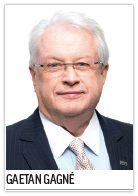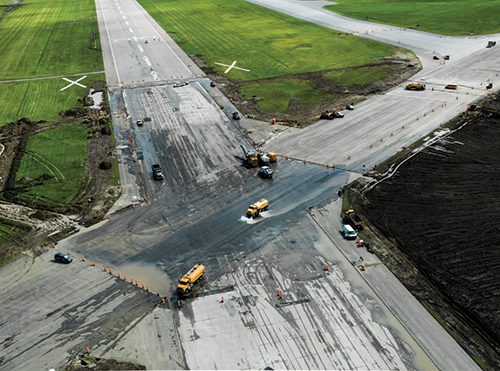Quebec City’s Jean Lesage International Airport (YQB) recently doubled the size of its terminal, made widespread technology upgrades and increased baggage handling capacity using an innovative project delivery method that had airport employees—not outside contractors—managing and coordinating all of the projects.
The terminal update is just one facet of a larger program, dubbed YQB 2018, the airport is undertaking to ready its facilities to accommodate 2 million annual passengers by 2020. Airport officials say the unique project management “org” chart and daily reliance on building information modeling (BIM) allowed YQB’s private sector owner, Aeroport de Quebec, to maintain control and finish the $277 million project on time and on budget.
“Based on our vision of Passenger First, we have chosen to build world-class infrastructures in order to respond to the worldwide growth in air travel and meet the needs of travelers in the Quebec City area,” says YQB President and Chief Executive Officer Gaëtan Gagné, noting that passengers will be the principal beneficiaries of the ambitious project.
|
facts&figures Project: Capacity-Enhancing Improvements Primary Components: Terminal expansion, baggage system improvements, technology updates, runway renovations Location: Quebec City Jean Lesage Int’l Airport Program Name: YQB 2018 Cost: $277 million Overriding Goal: Upgrade facilities to accommodate 2 million annual passengers by 2020 Timeline: Updated terminal opened in Dec. 2017, after 2 yrs construction Worksite Management: Pomerleau Architecture: GLCRM Terminal Seating: Artopex Civil Engineering: WSP Mechanical & Electrical Systems: SNC Lavalin Baggage Handling System: SNC Lavalin Automated Baggage Drop-Off System: Materna Building Structure: Stantec Airport Technologies: SITA Interior Design: Steve Girard Boarding Bridges: Adelte Baggage Handling System: Daifuku Passenger Entry Technology: BorderXpress Primary Inspection Kiosks, by YVR Runway Civil Engineering: Stantec; GBi: WSP Runway Electrical Engineering: Stantec Runway Lighting: OCEM; Anixter; Cooper Crouse-Hinds Of Note: Airport used building information modeling to keep project on budget & on time; airport employees managed project & subcontractors |
In addition to the recent terminal expansion and renovation, YQB 2018 also includes previous infrastructure improvements such as two runway resurfacing projects, the installation of new airfield electrical components and the construction of a multi-level parking facility.
The airport opted to use the BIM approach from the beginning of its multi-project program. The strategy proved effective in 2009, when YQB constructed a building to house its fire department and mechanical maintenance workshop; so airport officials took the approach further during the larger and more complicated YQB 2018 project.
“A multidisciplinary team of airport employees was in charge of managing the project; subcontracting companies reported to them,” explains YQB 2018 Project Director Marie-Noëlle Simard. “Most of the airport staff was already in office before YQB 2018. They were already familiar with the airport world and the vision beyond the project. The multidisciplinary team was formed with professionals of different fields of expertise, from engineers to IT, operations and communications specialists.”
Once staff and subcontractors were in place, an “intelligent 3-D model” of the terminal was created for use by everyone involved in the process. Project teams then worked together to design, visualize, simulate and collaborate throughout the project lifecycle, explains Simard. The 3-D model was updated weekly, so participants could visualize developments as the new terminal progressed.
Everyone Under One Roof
Simard emphasizes the benefits of co-locating about 100 key personnel from various firms and trades in a large project office the airport created in an unused aircraft hangar. “This unorthodox approach gives service providers the rare privilege of sharing a space and communicating face-to-face on a daily basis for the ultimate in fluid, efficient communication,” she remarks. “And BIM held us to continually review our work, our timeframe and budget.”
The team office has proved valuable on many occasions, including an instance when personnel discovered that a ventilation duct was interfering with a structural modification. “When a snag like this is caught at the design phase, the architect can simply pop over to the engineer’s desk to discuss the solutions,” Simard explains. “Then, they come up with a fix together, make the necessary adjustments and voila, problem solved, with no unpleasant surprises during construction.”
Subcontractors working on the project are also enthusiastic about the office arrangement and delivery process the airport used. SNC-Lavalin, for instance, was responsible for the complete design, request for proposal support and construction surveillance of the mechanical, electrical and plumbing aspects of the terminal expansion and the baggage handling system (arrivals and departures systems). Marie Manseau, the company’s project director, says that the BIM approach facilitated multidisciplinary coordination, calculations, estimating and specifications. She also acknowledges that the process was not universally intuitive. It was a challenge to have all stakeholders “step into the BIM revolution,” she explains.

Simard agrees: “It is a new approach and almost everyone who worked with us never did it before. But we were very well prepared. We had the right people in the right places to implement the procedures correctly.”
December Debut
Construction on the terminal extension began in 2015, and the new facility opened to passengers in December 2017. During the course of the project, YQB:
• doubled the size of its terminal from 270,000 square feet to 540,000 square feet;
• added four gates, bringing the grand total to 12;
• expanded its airside food court and restaurant space to accommodate four restaurants (previously, there was only room for one);
• created a new duty-free store four times larger than its predecessor;
• installed new communications and signage systems; and
• added charging stations for smartphones and tablets; and
• installed an additional baggage carousel for international flights (previously, there was only one).
“It was a problem when we had two international flights coming in at the same time,” recalls Simard. “Now, we have better flow between the Customs area and the baggage carousels. We have more capacity, and we can now have four flights coming in at the same time and it is not a problem.”
Many of YQB’s check-in counters now offer passengers the option of using the airport’s new automated baggage drop-off system by Materna or receiving assistance from an agent. In addition, updated check-in kiosks were installed to provide a more efficient process for passengers and airline staff.
The airport also added 14 Border Xpress Primary Inspection Kiosks by YVR (Vancouver International Airport). The new machines, which debuted in December with the terminal addition, can be used by most incoming travelers entering Canada from U.S. or international destinations.
 With the new terminal now open for business, Phase 2 of the project has begun—joining the original terminal and new addition with a middle connector area. “This is a big challenge,” notes Simard. “Passengers have to go through this construction to walk from the old terminal to the new addition.” Phase 2 is scheduled to be complete by the end of 2019.
With the new terminal now open for business, Phase 2 of the project has begun—joining the original terminal and new addition with a middle connector area. “This is a big challenge,” notes Simard. “Passengers have to go through this construction to walk from the old terminal to the new addition.” Phase 2 is scheduled to be complete by the end of 2019.
Environmental responsibility was a major goal from the beginning of the project. “Before we even started construction, we asked our subcontractors to tell us everything we could do to ensure the highest level of sustainability,” says Simard
Key environmental measures include a new geothermal exchanger (with 54 loops that are 550 feet deep); energy-efficient LED lighting; heat recuperation; radiant floor heating; variable speed drives on all HVAC systems to regulate airflow based on a set of parameters, such as terminal occupation; low-temperature heating; and condensation boilers.
“The airport’s heat recovery system is the cornerstone of our energy savings strategy,” notes Manseau. “We are able to take heat that we remove from spaces that need cooling and send it elsewhere in the building where heat is required. When we have more heat recovered than we need, we store it in the geothermal exchanger, which operates like a bank. We can store heat in the summer to recover it the following winter.”
 Technological Review
Technological Review
The airport worked with SITA to develop a new “concept of operations” and identify future technology requirements for new and existing facilities. The scope included a holistic review of 20 systems across airport operations, passenger processing, security, infrastructure (LAN, WLAN and VOIP) and building management.
“Over a six-month period, we conducted a thorough gap analysis of the airport’s operating requirements, interviewing teams across the business to understand their operations and expectations,” explains Jeremy Springall, vice president of Business Integration and Solutions for SITA. “Based on this analysis, we were able to develop a new concept of operations and associated technology specifications, taking into account the airport’s growth objectives. The concept of operations is used to describe the user organization, mission and organizational objectives from an integrated systems point of view. It also details the systems, processes, resources, training and maintenance to support those operations.”
Springall notes that the technical specifications document was a key piece of information for the airport because it made clear recommendations on the technology needed to support YQB’s new approach to operations.
 “We advised the airport management which systems would need replacing, kept or enhanced over a period of years,” he explains. “These recommendations took into consideration cost-savings, passenger growth, changing requirements from operations and passengers, and, of course, the investment in new technology over the next few years. The implementation of these changes and subsequent technology investments has significantly improved the efficiency of the airport.”
“We advised the airport management which systems would need replacing, kept or enhanced over a period of years,” he explains. “These recommendations took into consideration cost-savings, passenger growth, changing requirements from operations and passengers, and, of course, the investment in new technology over the next few years. The implementation of these changes and subsequent technology investments has significantly improved the efficiency of the airport.”
Another important element of YQB 2018 already in place is a new parking garage that nearly doubled the airport’s available capacity to about 2,000 spaces. Built in 2013, the 450,000-square-foot parking garage is located directly adjacent to the new terminal and includes an automated system that tells motorists how many spaces are available on each of the structure’s five levels.
Airfield Improvements
The airport also updated its two runways during the course of YQB 2018. In 2016, contractors refurbished the center part of Runway 11-29 and the area where it intersects with the main runway, 06-24. Thirteen days were allotted for rehabbing the intersection area, but crews worked 24/7 and finished in 12 days, reports Sandra Gauvin, project manager for WSP.
 “It went very well because we did a lot of planning with the airport, the contractors and the subcontractors,” says Gauvin. “We ensured that all materials were onsite, ready for use before we started. And, we did a preliminary run-through before we started. So when we got to work that first Monday, everything was ready to go.”
“It went very well because we did a lot of planning with the airport, the contractors and the subcontractors,” says Gauvin. “We ensured that all materials were onsite, ready for use before we started. And, we did a preliminary run-through before we started. So when we got to work that first Monday, everything was ready to go.”
Crews also installed a new drainage system on Runway 06-24. “At Quebec Airport, we are in an area where water is coming from all sources. The groundwater is very high and the drains are used a lot,” Gauvin explains. “Because we couldn’t change the drains on the runway, we applied a new concept to relieve the drains. We created underground retention ponds to capture the groundwater before it arrives to the runway drains.”
Finishing Runway 11-29 in 2016 was critical, because the airport needed a runway in excellent condition when it closed its main runway for improvements in summer 2017, she explains.

Work on 06-24 in 2017 was far more comprehensive. It took 80 days to resurface the entire runway, add more than 80 kilometers of updated electrical cables, install 88 new high-intensity LED runway lights and add new approach lighting. The upgraded lighting system runs on two parallel circuits, so pilots on approach will have visual cues even during a power failure.
 Ready for More Passengers
Ready for More Passengers
Simard is pleased with the successful completion of the terminal expansion. “The BIM approach allowed us to detect thousands of anomalies in the plan and to correct them in the virtual model,” she remarks. “This means that hundreds of problems were avoided on the worksite, and those problems would have been way more expensive to deal with if they had materialized.”
YQB’s passenger traffic reached 1.67 million in 2017, an increase of 3.4% from the previous year; and the volume is predicted to continue growing. “Inspired by our vision of Passenger First, we have chosen to create world-caliber infrastructure to join the top 10 of the country’s most-visited airports. YQB 2018 will accelerate the transformation of our organization and drive our growth, for the benefit of all our passengers.”

Gagné notes that an average increase of 1,000 passengers per week shows that travelers from the greater Quebec City area are choosing YQB. “These results are no accident,” he observes. “They reflect our hard work and major investments in our facilities to give our passengers a world-class airport.”



